过去分词_语法___高中英语必修五_unit1Great_scientists-Grammar课件_新人教版必修
- 格式:ppt
- 大小:5.52 MB
- 文档页数:28
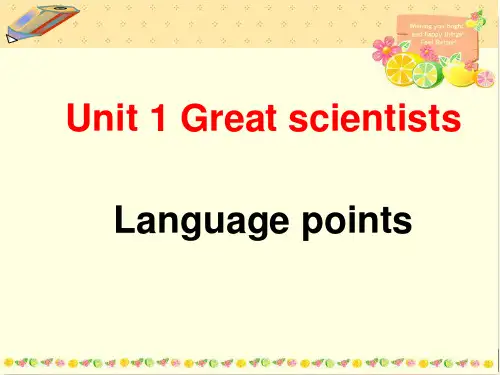
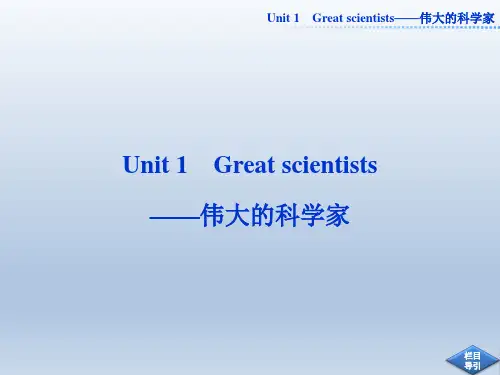
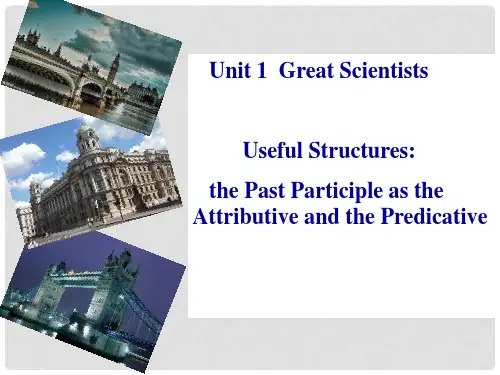
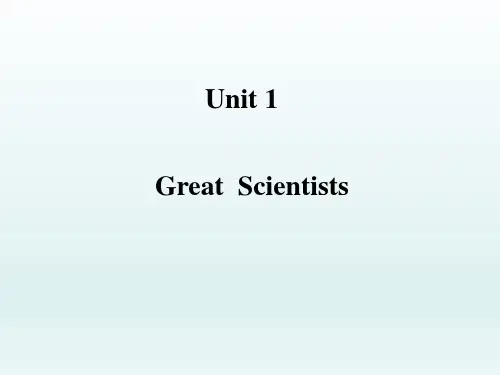

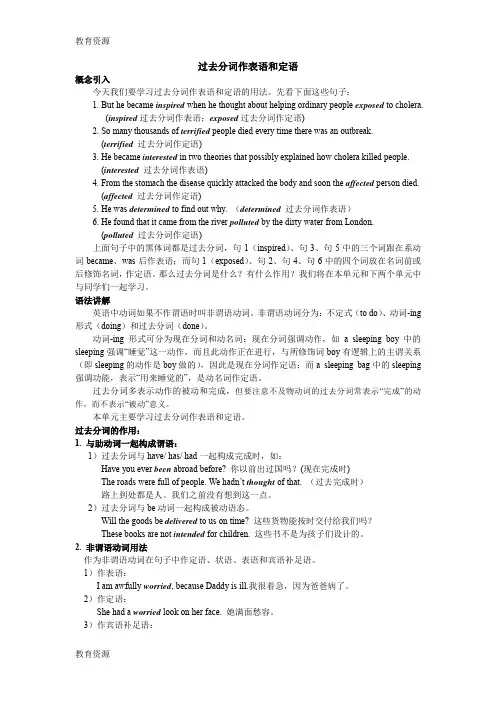
过去分词作表语和定语概念引入今天我们要学习过去分词作表语和定语的用法。
先看下面这些句子:1. But he became inspired when he thought about helping ordinary people exposed to cholera.(inspired过去分词作表语;exposed过去分词作定语)2. So many thousands of terrified people died every time there was an outbreak.(terrified过去分词作定语)3. He became interested in two theories that possibly explained how cholera killed people.(interested 过去分词作表语)4. From the stomach the disease quickly attacked the body and soon the affected person died.(affected过去分词作定语)5. He was determined to find out why. (determined过去分词作表语)6. He found that it came from the river polluted by the dirty water from London.(polluted过去分词作定语)上面句子中的黑体词都是过去分词,句1(inspired)、句3、句5中的三个词跟在系动词became、was后作表语;而句1(exposed)、句2、句4、句6中的四个词放在名词前或后修饰名词,作定语。
那么过去分词是什么?有什么作用?我们将在本单元和下两个单元中与同学们一起学习。
语法讲解英语中动词如果不作谓语时叫非谓语动词。
非谓语动词分为:不定式(to do)、动词-ing 形式(doing)和过去分词(done)。
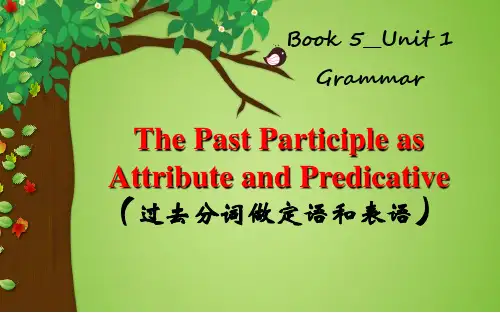
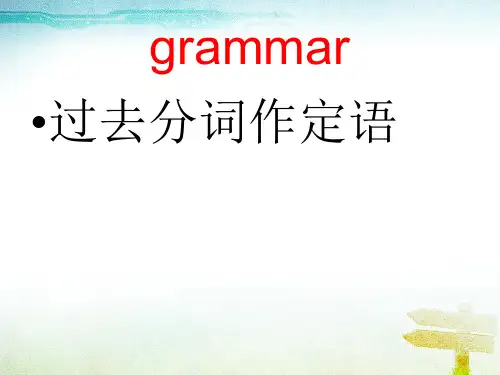
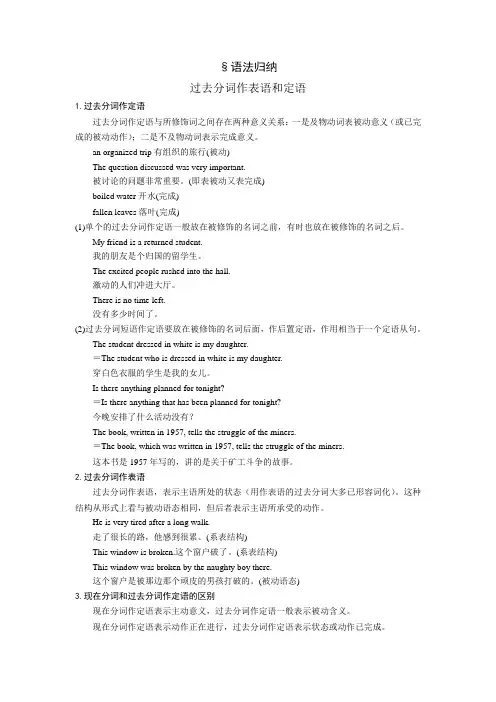
§语法归纳过去分词作表语和定语1.过去分词作定语过去分词作定语与所修饰词之间存在两种意义关系:一是及物动词表被动意义(或已完成的被动动作);二是不及物动词表示完成意义。
an organized trip有组织的旅行(被动)The question discussed was very important.被讨论的问题非常重要。
(即表被动又表完成)boiled water开水(完成)fallen leaves落叶(完成)(1)单个的过去分词作定语一般放在被修饰的名词之前,有时也放在被修饰的名词之后。
My friend is a returned student.我的朋友是个归国的留学生。
The excited people rushed into the hall.激动的人们冲进大厅。
There is no time left.没有多少时间了。
(2)过去分词短语作定语要放在被修饰的名词后面,作后置定语,作用相当于一个定语从句。
The student dressed in white is my daughter.=The student who is dressed in white is my daughter.穿白色衣服的学生是我的女儿。
Is there anything planned for tonight?=Is there anything that has been planned for tonight?今晚安排了什么活动没有?The book, written in 1957, tells the struggle of the miners.=The book, which was written in 1957, tells the struggle of the miners.这本书是1957年写的,讲的是关于矿工斗争的故事。
2.过去分词作表语过去分词作表语,表示主语所处的状态(用作表语的过去分词大多已形容词化)。
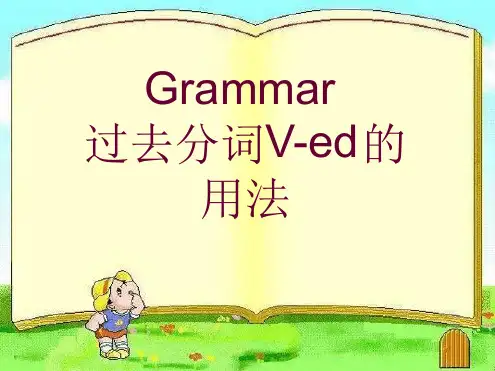
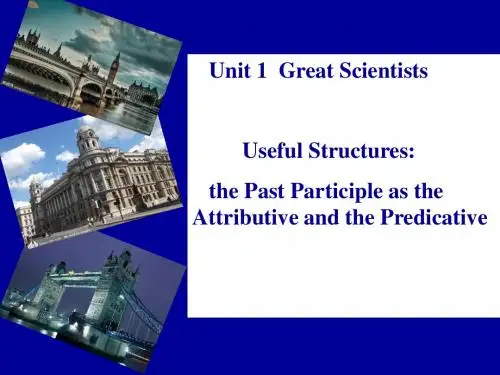
Unit1 Module 5 Great Scientists本单元教学内容分析:本单元主要话题是“科学家如何以探索、钻研、无畏的科研精神验证未知的科学原理。
”通过本单元的学习,了解科学家们对人类所做出的贡献及其成果。
本单元所涉及的要点是:(1)了解著名医生John Snow、钱学森、哥白尼等科学家以及他们的作为和故事。
(2)学习表示意愿、希望和建议的句型。
(3)学习过去分词作定语和表语的结构。
(4)学习写好“persuasive writing”,以训练学生的逻辑思维及写作能力.学情分析:课时分配:8课时T he 1st Period warming up and pre-readingThe 2ndand 3rd Periods ReadingThe 4th and 5th Periods GrammarThe 6th Period Reading and writingThe 7th and 8th periods Main RevisionThe 1st Periodwarming up and pre-readingTeaching Aims:1. Learn some new words and expressions.2. Know some great scientists and their achievements.3. Knowsome important qualities a scientist should have and the stages in examininga new scientific idea.Difficult and Important Points:1.Word study2.Discuss in groups the stages in examining a new scientific idea.Teaching Methods:1.Inductive method2.Pair work & group work3.Word Study according to the situations given (Do exercises)Teaching Procedures:Step1. Warming-up1. There are some great scientific achievements that have changed the world. Can you name some of them? What kind of role do they play in the field of science? Do these achievements have anything in common? Match the inventions with their inventors below before you answer all these questions.Alexander Bell electricityThomas Edison the First telephoneLaity Brothers the electric LampMadame Curie black holes in UniverseFranklin Theory of GravitySteven Hawking the First PlaneElbert Einstein RadiumIsaac Newton the Theory of Relativity2. Who found the cure for SARS? (钟南山)Why is SARS so horrible?What kind of disease is SARS?----infectious disease3. Can you name any other infectious disease? ----SARS, AIDS, bird flu(2005), choleraH1N1,HFMD(手足口病)Step2. Pre-reading1. Cholera may be rare nowadays except in some poor areas, but back in the 1830s-1840s, it was probably No.1 killer in the world. There were four outbreaks of cholera in the 1830s and 1840s, which killed many thousands of people in the industrial cities of England. In 1854 on August 31st “the most terrible outbreak of cholera which ever occurred in the kingdom” began. It was so violent and sudden that 127 people around Broad Street died in the first three days. And then a famous physician John Snow discovered the source of the disease and since then Cholera was finally brought under control.2. How did he solve the problem of cholera? Actually, he followed a scientific procedure to carry out his scientific research. The whole procedure is made up of 7 steps. Can you put them in a right order?Draw a conclusion Think of a method Collect results Make up a question Find a problem Analyze the results Repeat if necessaryStep 3 SummaryStep 4 Homework Assignment1.Read the passage John Snow Defeats “King Cholera”.2. Learn the new words by heart and prepare for tomorrow’s dictation.课后反思:The 2ndand 3rd Periods ReadingTeaching aims:1. Learn some new words and expressions.2. Improve the students’ reading skills.3. Know how to prove a new idea in scientific research.Difficult and Important Points:(1)Reading comprehension(2)What did John Snow do to prove a new idea in scientific research?Teaching Methods:1. Group work2. Competition3. Illustration4. Deductive MethodTeaching Procedures:Step 1Lead inBackground introduction to John SnowJohn Snow (1813-1858) was born and worked as a doctor in Great Britain. He was originally an anesthetist(麻醉师).He was so famous that he became the doctor for Queen Victoria at the births of her many children.Four outbreaks of cholera in the 1830s and 1840s killed many people in England. In 1854, “the most terrible outbreak of cholera which ever occurred in the kingdom” began. It was so violent and sudden that 127people died in the first three days. Step 2 Skimming and ScanningMore questions are given to get the general ideas of this passage and some obvious facts.Who defeats “King Cholera“? John SnowWhat happened in 1854? Cholera outbreak hit London.How many people died in 10 days? 500Why is there no death at No. 20 and 21 Broad Street as well as at No. 8 and 9 Cambridge Street?These families had not drunk the water from the Broad Street pump.Step 3 Reading for details1. Why couldn’t the cholera be under control at first?Neither its cause, not its cure was understood.2. Which theory did John Snow believe in?People absorbed cholera into their bodies with their meals.3. John Snow finally proved the theory he believed by ________.gathering information with the help of a maplooking into the source of the water for Broad Street and Cambridge Street Separating those who suffered cholera from those who didn’tBoth A and B (right choice)4. To prevent the cholera from spreading again, what did John Snow do? Suggested that the source of all water supplies be examine. Suggested that new methods of dealing with polluted water be found. Instructed the water companies not to expose people to the polluted water anymore.Step 4 Summing up: Read the passage silently and quickly and match the stages ofThe same with above:Find a problem draw a conclusion Think of a method Collect results Make up a question Analyze the results Repeat if necessaryParagraph 1: Introduction of John Snow and CholeraParagraph 2: Two theoryParagraph 3-5: Study of the breakout in 1854Paragraph 3: Think of a method: Test two theoryCollect the result: Mark the deathAnalyze the result: Reason for death and no deathParagraph 4: Analyze the result: Find the resource of the waterParagraph 5: Repeat if necessary: Find more evidence.Draw a conclusion: Cholera was spread by germPolluted water carried cholera Paragraph 6: Prevention of CholeraStep 5 Retell the passage (文章缩写仅供参考)Provide ss with a summary with some blanks. Let them retell the passage as well as pay attention to some important words.Read the passage again and fill in the blanks:John Snow was a well-known ____ in London in the ___ century. He wanted to find the ______ of cholera in order to ______ it. In 1854 when a cholera ____ out, he began to gather information. He _____ on a map where all the dead people had lived and he found that many people who had drunk the dirty water from the ______ died. Sohe decided that the polluted water carried cholera. He suggested that the _____ of all water supply be _______ and new methods of ________ with polluted water be found. Finally, “King Cholera” was defeated.Key: (见课文和教师用书)Step 6Language learning1.So many thousands of terrified people died every time there was an outbreak. 每当(疾病)突发时,总有成千的人死去【句型剖析】 1)本句是一个复合句,every time引导的是一个时间状语从句,意思是“每当……”,相当于“when”。
Unit 1 Great scientists Period 4 Grammar ---过去分词学习目标:1. 知识目标:掌握过去分词做定语和表语的用法。
2. 能力目标:能判断并正确应用过去分词,重点掌握过去分词和现在分词的区别3. 情感目标:欣赏英语语言的魅力。
学习重点:掌握过去分词做定语和表语的用法学法点拨:仔细阅读有关过去分词做定语和表语的讲解,分析例句和习题体会过去分词的用法。
预习案第一部分:复习上学期我们学习了现在分词的用法,经过一个假期的“遗忘” ,现在我们来考考自己的记忆力吧!1. You should be familiar with the town. Don'y t ou remember __________________ (take) here atthe age of 7?2. It is no use ____________ (regret) for the mistake you have made.3. ___________ (collect) information is very important to business.4. Listen! Do you hear someone _____________ (cry) for help?5. He hurried to the railway station only _____________ (tell) that the train had already left.6. __________ (hear) the ________________ (excite) news, all the students were very__________ . (excite)7. Do you know the girl ________________ (stand) under the tree?8. The meeting ________________ (hold) next week will be of great importance.第二部分:过去分词作定语(一) 、请仔细阅读下列例句,体会过去分词作定语的用法。
人教版高中英语必修五Unit1Greatscientists牢固练习过去分词作表语和定语高中英语学习资料madeofjingetieji牢固练习Ⅰ. 用动词的正确形式填空:1. Seeing the _______ (frighten) snake, the _______ (frighten) girl held her father’ s arm2. A theory ________ (put) forward by Einstein is well known to all.3.What’ s the language_______( speak) in that country?4.We must keep a secret of the things ________ (discuss) here.5. A woman, _______ (dress) in a beautiful blouse came in and sat in the first row.6.Your mother was _______ (annoy) at your saying that.7.The house ________ (stand) at the corner of the street was built at the beginning of lastcentury.8.— Can those ________ (seat) at the back of the classroom hear me?— No problem.9.The flower _______ (smell) terrible should be taken out of the room.10.He seemed quite ________ (delight) at the news.11.The first three rows of the hall are _______ (reserve) for special guests, so you can ’tsit here.12.I followed my brother and entered a dark ________ (crowd) room.13.He walked up and down the room, like an animal ________ (trap) in a cage.14.Many people became ________ (terrify) of cholera and began to move out of the village.15.I will take the vase _______ (break) by my son to that old man to see if he can mend it.Ⅱ. 用非谓语动词把下面复合句改成简单句。